100 Years of Federal Forestry
Agriculture Information Bulletin No. 402
|

|
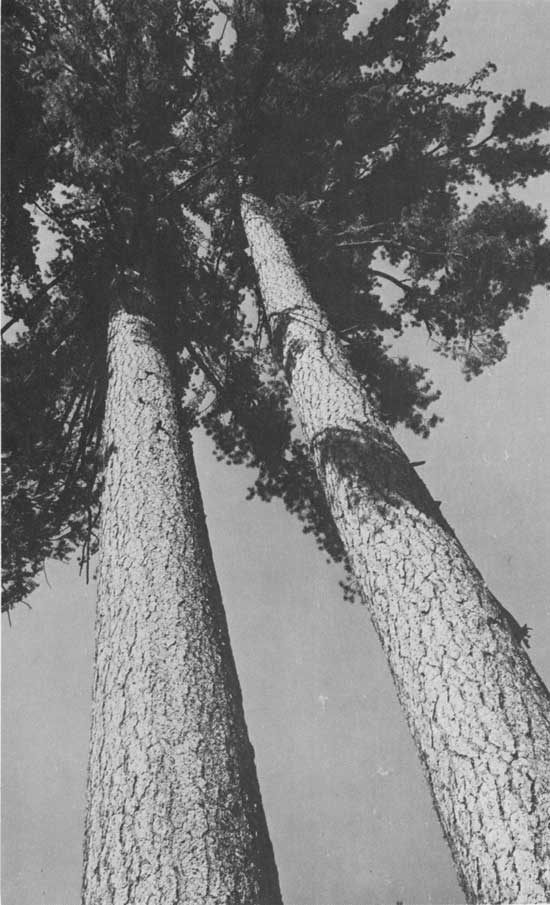
|
|
1. Sugar pines, Sequoia National Forest, California. (F—504980)
|
Keeping Up With The Times, 1961-1975
Highlights
On July 1, 1876, the population of the United States,
as then constituted, was roughly 46.1 million.* On July 1, 1975, our
population was estimated by the Census Bureau to be 213.5 million,
including the Armed Forces overseas. With this increase of 167.4 million
men, women, and children in 100 years, and with our natural resources
less abundant than a century earlier, there was need to stretch these
resources, especially the forests, to their greatest possible, practical
use. To accommodate the demands of the ever-growing population (there
were 34.7 million more people in the country in 1975 than in 1961), the
National Forest System was called upon to yield more wood, more water,
more recreation, more range forage, and more wildlife habitat than ever
before. Other Federal outdoor areas and the privately owned forests also
felt the pinch.
*Historical Statistics of the United States
(U.S. Department of Commerce).
As a consequence, the period from 1961 to 1975 was
one of greater challenges for the Forest Service than it had faced
before. A change of direction was needed to meet the needs of the new
era efficiently and effectively. This changeover was characterized by a
gradually quickening shift from short-term management concepts to fully
planned, longer range management. This conscious effort to keep up with
the time brought notable advances.
The Forest Service instituted the principles of the
Multiple Use-Sustained Yield Act (1960) throughout the National Forest
System. The purpose of the Act was to insure that all possible use and
benefit might be extracted from the public forests and grasslands
without endangering their future usefulness and productivity.
The activities of Forestry Research and State and
Private Forestry intensified, and emphasis on the use of
interdisciplinary teams increased. These teams represented a wide range
of specialities, for example, wildlife biologists, landscape
architects, soil scientists, range experts, engineers, and foresters.
The teams began working to meet current demands on the Forest Service
and to prepare plans designed to better mesh human needs with a
sustained supply of natural resources for the future.
The Nation became more conscious of its environment,
in a spirit akin to but more refined than that of the first decade of
the 20th century. There was a new appreciation of environmental values
and of the need to protect them, achieving expression in the National
Environmental Policy Act of 1969, which profoundly influenced Forest
Service planning and programs. In response to the heightened public
awareness of federal activities, the Service launched a program in the
early 1970's to "inform and involve" the people in the decisionmaking
process as it affected their interests in the forests. The goal was
meaningful public involvement in developing better land and resource
management.
The most ambitious planning initiative of the Forest
Service involved 3 years of extensive effort culminating, in mid-1974,
with "A Long Term Forestry Plan (Draft)—Environmental Program for
the Future." This was a comprehensive plan involving the National Forest
System, Research, and State and Private Forestry. The Forest and
Rangeland Renewable Resources Planning Act (PL 93—378) of August
1974 coincided with the Environmental Program for the Future and was one
of the most significant Congressional conservation actions in many years
to have so great an impact on the future of American forestry. This Act
represented the first legislative recognition by Congress that
management of our natural resources can be fully efficient only when
planning and funding are done on a long-range basis, not
year-to-year.
The Resources Planning Act covered all Forest Service
areas of responsibilities and activities—the research and
cooperative programs and National Forest System management. It required
periodic analyses of present and anticipated uses, demands for, and
supply of renewable resources. The international resources situation
also had to be incorporated. The Act required that the first national
assessment and program be submitted to Congress by the end of 1975. In
complying, the Forest Service was able to draw on its own Environmental
Program for the Future for pertinent material on outdoor recreation and
wilderness, wildlife and fish habitat, rangeland grazing, timber, land
and water, and human and community development. The experience of the
first century of federal forestry thus in a blueprint for the next
century.
1961-1975
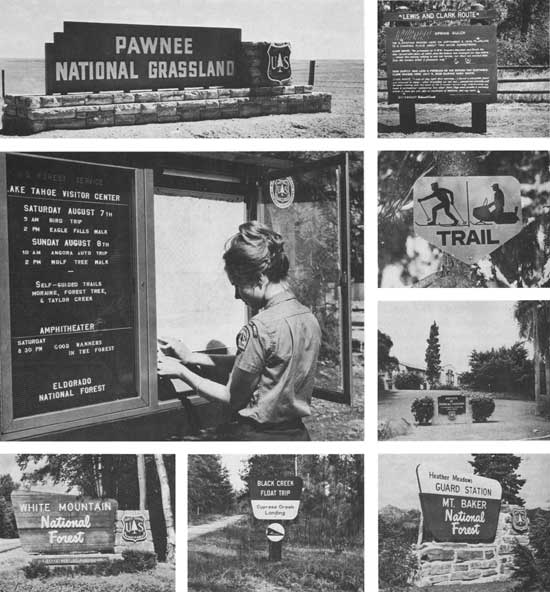
|
|
Signs— 1 (top left). Colorado. (F—503670) 2 (middle left). California. (F—513408)
3 (bottom left). New Hampshire. (F—515783) 4 (bottom center). Mississippi. (F—515920) 5 (top right).
Montana. (F—515566) 6 (2nd from top right). Oregon. (F—519209) 7 (2nd from bottom right). Puerto Rico. (F—522904)
8 (bottom right). Washington. (F—514484)
|

|
|
1 (top). Water for a hundred purposes . . . (Gifford Pinchot National
Forest, Washington). (F—516462) 2 (bottom). Wood for a thousand uses . . . (Ozark National Forest,
Arkansas). (F—504877)
|
Sidelights (1961-1975)
During this period an interesting trend began to
develop, a trend with favorable portents for American forest
conservation and for the Forest Service of the future. There was a
special accent on youth through the Job Corps and the Youth Conservation
Corps, a new emphasis on State and Private Assistance through forestry
incentive programs, an introduction of modern techniques in forest
management and forestry research, and an offering of new services and
opportunities for all Americans—a general upgrading of both
environmental and human resources.
The Job Corps program, starting in 1965, gave young
men from deprived backgrounds basic schooling, training in skills, and
valuable job experience.
The Youth Conservation Corps was launched in 1971 as
a 3-year pilot program featuring summer conservation work-learn
activities for young men and women from all parts of the Nation and from
all walks of life. The Corps was continued beyond 1974 as a permanent
entity because of its success in providing gainful employment, in
accomplishing needed conservation work, and in arousing its youthful
participants to a new understanding and appreciation of their Nation's
environment and heritage. By 1975, State-operated projects on
non-federal public lands were in full swing along with projects being
carried on in National Forests, National Parks, Wildlife Refuges, and on
other public lands and waters.
In 1971, new survey techniques came into being as
satellite photos and imagery were used to make a sample survey of 12
million acres of forests in the Southeast.
Also, in 1971, Smokey Bear was joined by a new
comrade, Woodsy Owl, a symbol for wise use of the environment that
quickly captured the attention and cooperation of millions of
outdoor-loving Americans. The Woodsy Owl symbol and slogan, "Give a
Hoot, Don't Pollute," are authorized and protected by law, just as
Smokey Bear is.
"As the population of the country rises and demands
on the timber, forage, water, wildlife, and recreation resources
increase, the National Forests more and more provide for the material
needs of the individual, and the economy of the towns and States, and
contribute to the Nation's strength and well-being. Thus the National
Forests serve the people."
Edward P. Cliff (1962-1972)
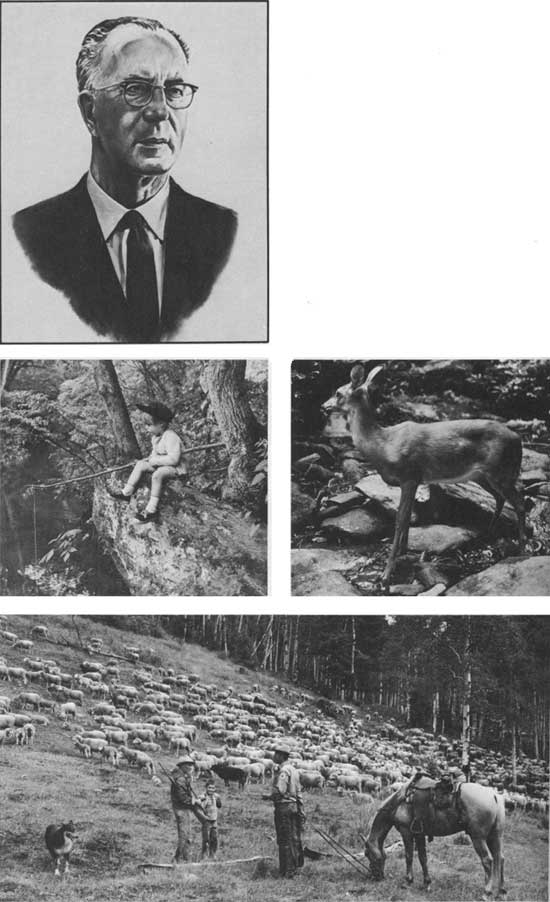
|
|
1 (top left). Edward P. Cliff, Chief of the Forest Service, 1962-1972. (Drawing by Rudolph Wendelin)
Domestic stock and wildlife . . . 2 (middle left). Fish. George Washington National Forest,
Virginia. (F—514850) 3 (middle right). Deer. Nantahala National Forest, North
Carolina. (F—494694) 4 (bottom). Sheep. Carson National Forest, New Mexico. (Forest Service,
Region 3, Carson National Forest)
|
1961-1975
In 1974, the Golden Anniversary of a priceless concept was observed
when the Gila Wilderness Area in the Gila National Forest, New Mexico, marked its
50th birthday. (Ten years earlier, in passing the Wilderness Act, Congress had
legally endorsed a long-standing Forest Service policy of establishing and maintaining
wilderness areas.)
The 50th anniversary of the Clark-McNary Act
was also observed in 1974, reflecting a dramatic evolution of State and Private Forestry
through the years, with ever-closer ties between the States and the Forest Service for the
good of the public and the forest resources.
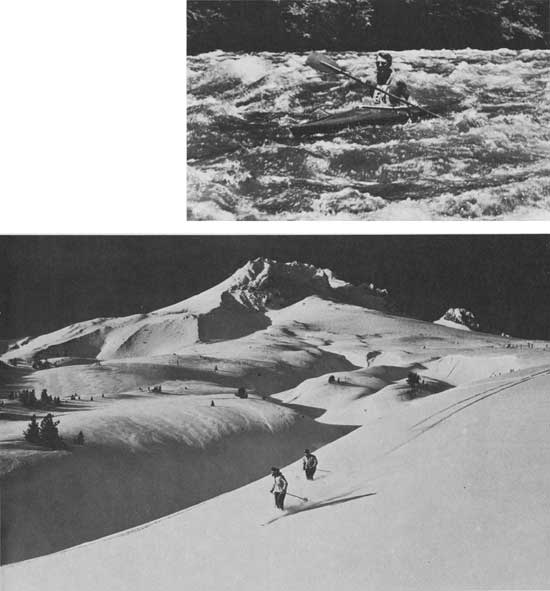
|
|
Recreation to fit every taste . . . 1 (top). Whitewater Championship
Canoe Races, Feather River, Plumas National Forest, California (1970). (F—519847) 2 (bottom).
Skiing, Mount Hood National Forest, Oregon. (F—499444)
|
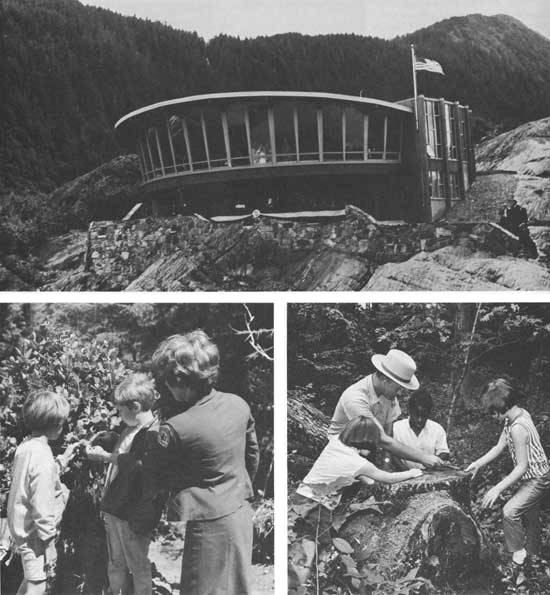
|
|
The Visitor Information Service of the Forest Service—specially
trained men and women and special facilities to further one's knowledge, to add zest to
the outdoor adventure, to enhance the visitors' enjoyment. 1 (top). Far North, in the Tongass
National Forest in Alaska, the Visitor Information Center makes viewing of the
Mendenhall Glacier a safer and more informative adventure. (F—518534) 2 (bottom left). The Cape
Perpetua Visitor Information Center on the Pacific Ocean captures the interest of young
plant examiners (Siuslaw National Forest, Oregon). (F—516687) 3 (bottom right). The annual growth
rings tell the age of a tree—the fast-growing years and the slow ones, the dry years
and the wet ones, and, quite often, there are marks of fires that had run wild through the
forest (George Washington National Forest, Virginia). (F—518780)
|
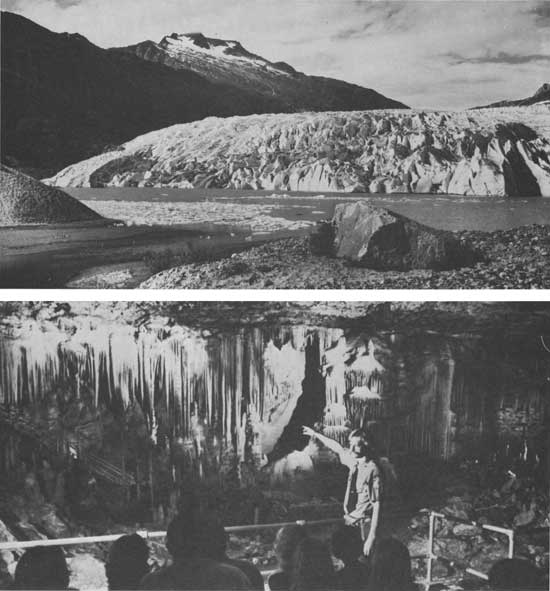
|
|
1 (top). Face of Mendenhall Glacier across Mendenhall Lake. (F—486789)
2 (bottom). A geological treat—Blanchard Springs Cavern in the Ozark National
Forest, Arkansas. (F—512984)
|
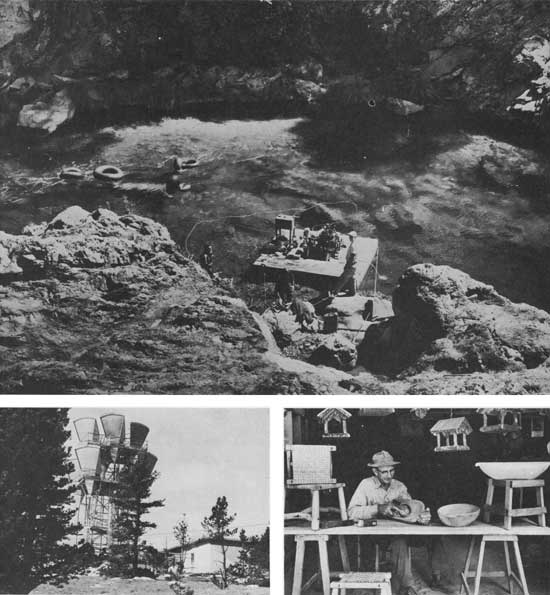
|
|
The Forest— 1 (top). There's gold in the river. In 1962, scuba divers
"vacuumed" the precious metal from the bottom of the North Yuba River in the Tahoe National
Forest, California. (F—503106) 2 (bottom left). A microwave station built in the early 1960's made this part
of the Helena National Forest, Montana, a high-value special-use area. (F—502316) 3 (bottom right). From farm
forests in North Carolina come the raw materials for hand-crafted wooden creations that have kept
many mountain and other rural residents profitably employed. (F—502169)
|
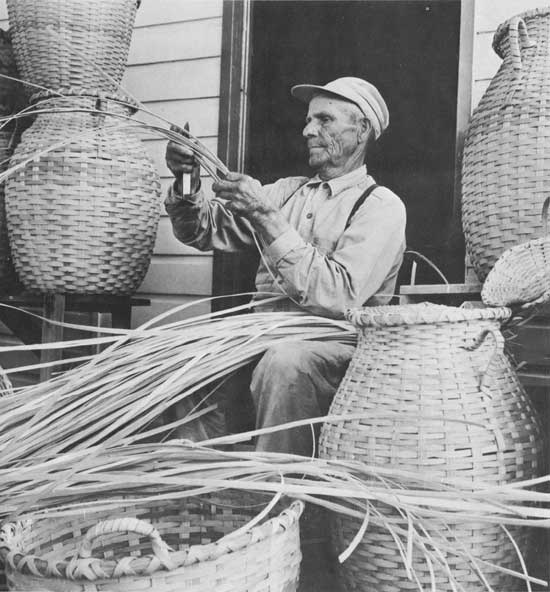
|
|
1. In Virginia these baskets are woven from oak splits and are
popular with tourists. The raw material comes from white oak from nearby farm forests.(F—508221)
|
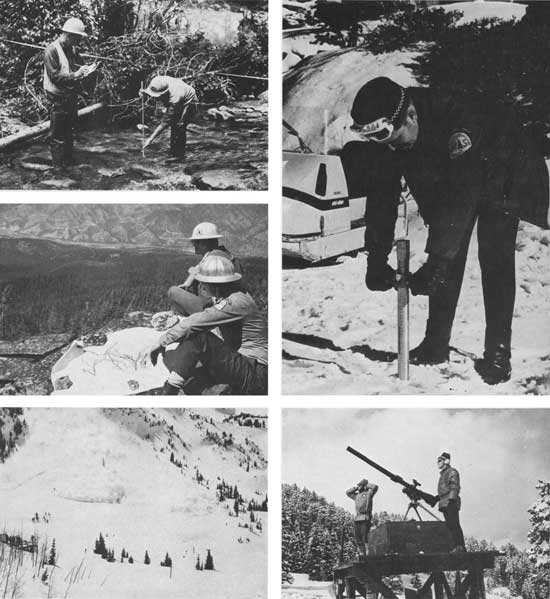
|
|
"All in the day's work . . ." 1 (top left). Stream habitat surveys indicate
quality of the aquatic environment and provide basic management data (Bitterroot National
Forest, Idaho, 1967). (F—519357) 2 (middle left). Checking terrain for suitability for skiing (Lolo National
Forest, Montana, 1966). (F—515020) 3 (bottom left). Avalanches can travel up to 100 miles per hour, and
carry well over 100,000 tons of snow and debris. Anything in the path of a large avalanche
is usually totally destroyed. The Forest Service supervises avalanche control activities at
developed ski areas with the objective of reducing the hazard to life and property (Wasatch
National Forest, Utah). (F—462494) 4 (top right). Measuring snow depth in February to determine summer
run-off possibilities (Tahoe National Forest, California, 1970). (F—520149) 5 (bottom right). Controlling
snow avalanches with 75mm recoilless rifle fire (Gallatin National Forest, Montana, April
1970). (F—520642)
|
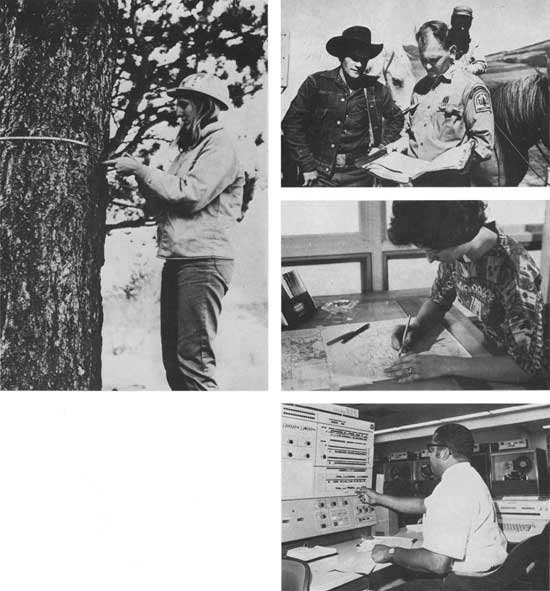
|
|
1 (top left). In the summer of 1965, a forestry technician on the
Lewis and Clark National Forest in Montana measured the diameter of a tree to
determine the volume of wood in it; (F—521722) 2 (top right). The District Forest Ranger checked
the range allotment map with a ranch foreman, the two men discussing details of the
grazing permit agreement, on the Routt National Forest, Colorado. (F—512720) 3 (middle right).
Meanwhile, back at a district ranger office in the Beaverhead National Forest, Montana,
the District Clerk prepared a similar range allotment map; (F—504545) 4 (bottom right). And, in
the Chief's headquarters in the Nation's Capital, another technician kept busy in the
Automatic Data Processing Center. (F—519994)
|
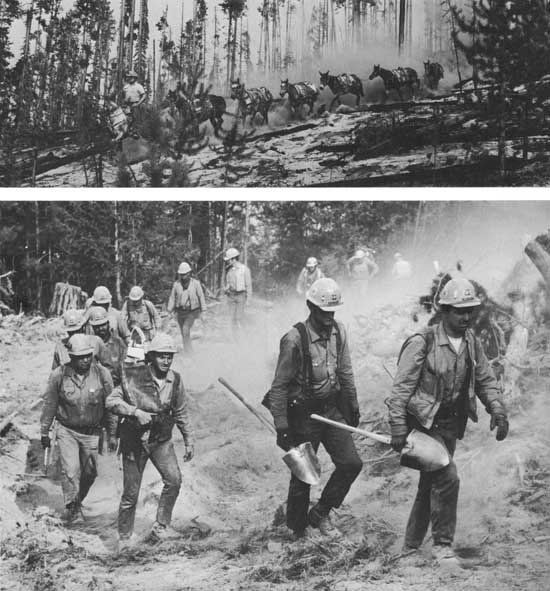
|
|
Protecting the forests—a never-ending responsibility.
1 (top). August 1961—1,650 men in 16 camps worked to control the
Sleeping Child Fire in the Bitterroot National Forest, Montana. Pack strings
helped supply fire camps that were inaccessible by road. (F—507314) 2 (bottom). August
1970—fire struck heavily on the Wenatchee National Forest in Washington.
Men moved up to the fire on foot. (F—520885)
|
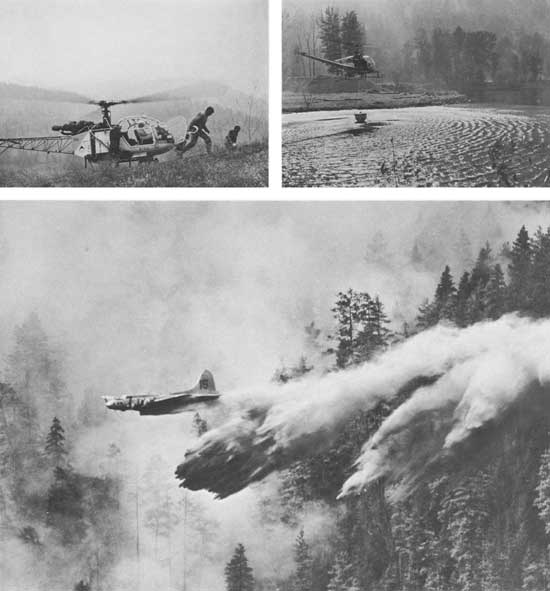
|
|
1 (top left). Men also moved up to the 1970 Wenatchee Fire in
helicopters. (F—520902) 2 (top right). Water helped douse small spotfires . . . (F—520897) 3 (bottom). And
retardant was dropped from airtankers to slow down the fire's spread. (F—520868)
|
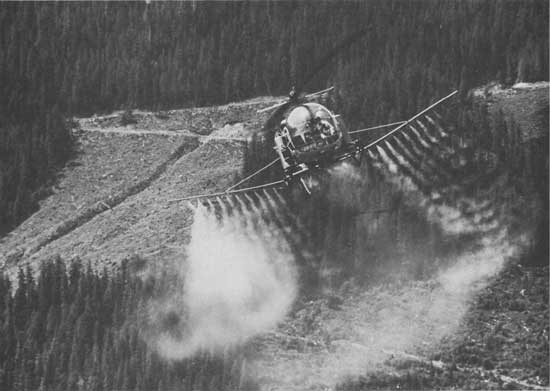
|
|
1. A different kind of spraying job took place on the Mt. Baker
National Forest in Washington during the summer of 1968—spraying with an
insecticide to control the ravages of the Hemlock Looper. (F—519176)
|
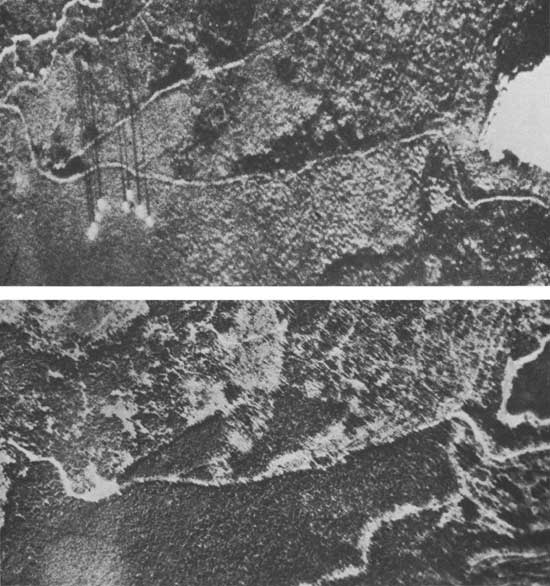
|
|
1 (top). Infrared photography became a valuable Forest Service
aid in the 1960's. The eight white lights (from eight small smudge pots) in
the lower left-hand corner were photographed using infrared imagery. (F—518607) 2 (bottom).
In this photograph, made with standard camera and film, the smudge pots do not
show up. Use of infrared photography makes it possible to locate fires while
they are still small, before they reach a dangerous stage. (F—518608)
|
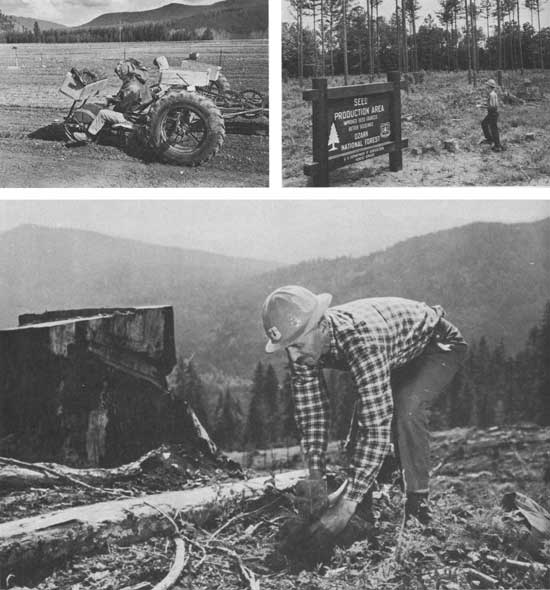
|
|
Planting for the future . . . 1 (top left). Transplanting 2-year-old
ponderosa pine seedlings in Savenac Nursery, Coeur d' Alene National Forest, Idaho
(1963). (F—504419) 2 (top right). Checking the seed production area on the Ozark National
Forest, Arkansas (1963). (F—505693) 3 (bottom). Tree planter at work in a clear cut area,
Gifford Pinchot National Forest, Washington (1965). (F—521178)
|
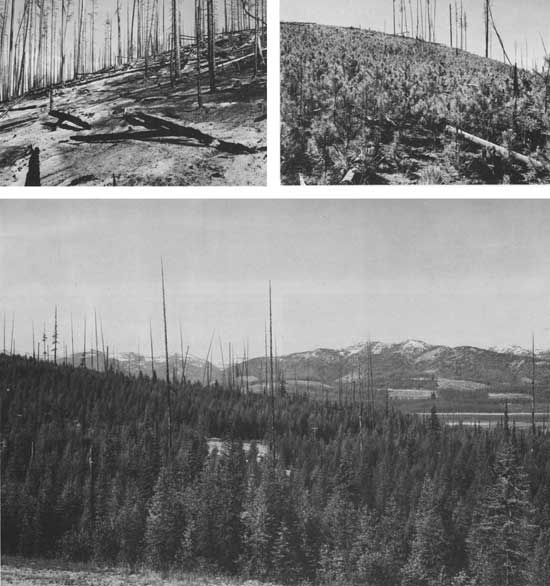
|
|
1 (top left). The aftermath of the Sleeping Child Fire, Bitterroot
National Forest, Montana, 1961. (F—522310) 2 (top right). Ten years after the Sleeping Child
Fire, the forest stages a comeback (Bitterroot National Forest, Montana, 1971). (F—522309)
3 (bottom). Stand of western larch reclaim an area damaged by a forest fire
(Flathead National Forest, Montana, 1967). (F—522055)
|
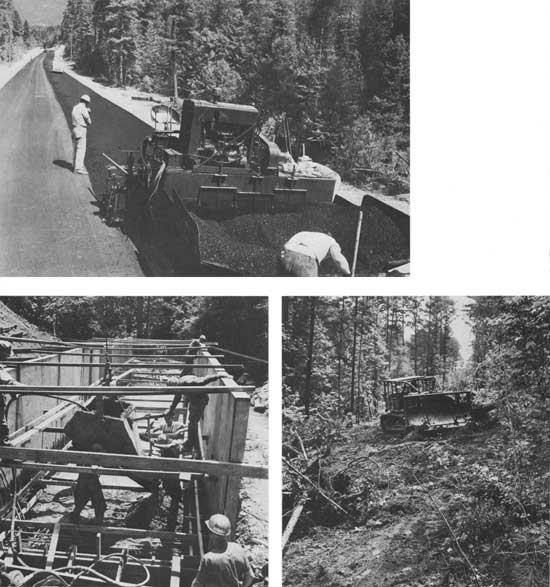
|
|
Road building—a major activity . . . As tools became more
sophisticated and techniques more modern, the Forest Service engineer began to
build his roads following straighter, safer, and faster routes. He gentled
the dangerous curves, bridge rivers, and bored through mountains. More speed
and more efficiency have become important as demands for wood, for recreational
outlets, and forest mobility have grown. The necessity has remained, however,
to maintain the beauty and integrity of the environment. In addition to building
roads and trails within the National Forest System, Forest Service engineers,
landscape architects, and other specialists also are responsible for the planning,
location, and operation of dams, buildings, power lines, water and sewer systems,
ski lifts, and generating plants—for management purposes, public use, or,
under permits, for commercial use. 1 (top). Kootenai National Forest. (F—506136) 2 (bottom
left). Sumter National Forest, South Carolina. (F—516310) 3 (bottom right). Talladega National
Forest, Alabama. (F—505732)
|
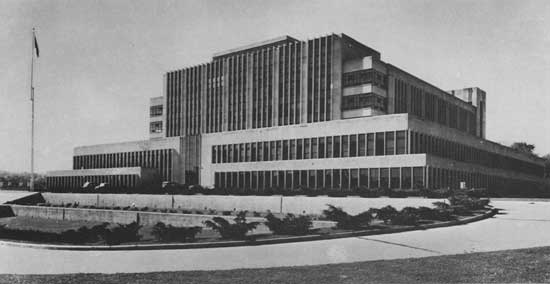
|
|
1. The Forest Products Laboratory at Madison, Wisconsin, is the
headquarters for the Federal Government's wood utilization research activities.
Through the years, FPL has proved to be a boon to government and industry alike,
with tremendous benefit to the public. (F—405515)
|
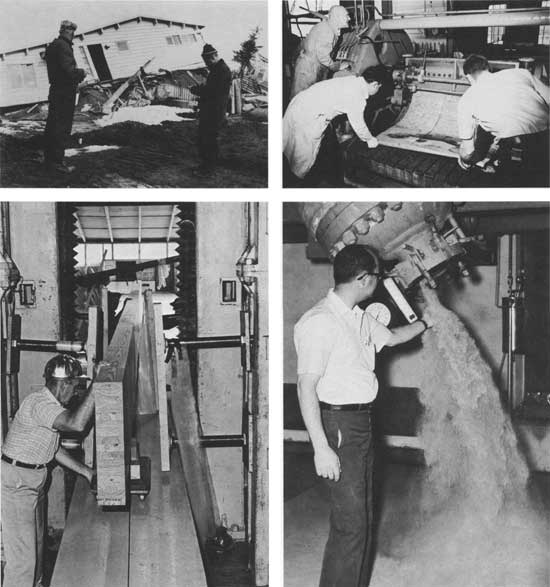
|
|
The Forest Products Laboratory . . . 1 (top left). Four days after an
earthquake struck Anchorage, Alaska, in March 1964, FPL engineers were checking the
damage to light, wood frame buildings to evaluate the quake's effects. They found
that well-built wood structures generally survived the quake fairly well. (Forest Products Laboratory, M 126 426 ) 2 (bottom
left). FPL-developed, massive, glued, laminated beams can stand tremendous stress and
strain. A series of binding tests to get data for needed engineering design criteria
was completed in 1969. (Forest Products Laboratory, M 136 997—3 ) 3 (top right). A key 1969 research effort developed by FPL
scientists to increase the yield and quality of wood products. In the process, low-grade
logs are cut into continuous sheets, 7/16-inch thick, peeled from a rotating log by a
knife. The resulting veneer is cut into short strips, press dried, glue laminated,
and made into planks of lumber. Time: 30 minutes. (Forest Products Laboratory, M 139 025—11) 4 (bottom right). Sawdust (in this case,
aspen) as livestock food? It was explored in the late 1960's and demonstrated its value
as such. (Forest Products Laboratory, M 137 451—1)
|
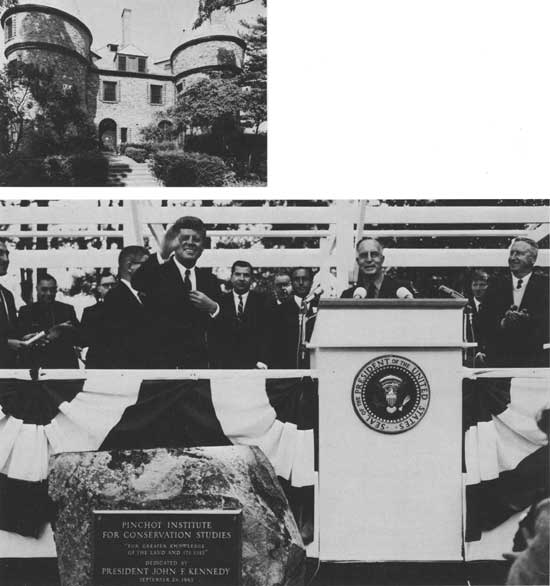
|
|
The Pinchot Institute for Conservation Studies . . . 1 (top left). The Grey
Towers, family home of Gifford Pinchot, Chief Forester 1898-1910, was donated to the Forest
Service by the Pinchot family, along with surrounding forest land, in 1963. It is now the
headquarters of the Pinchot Institute for Conservation Studies in Milford, Pennsylvania.
It has gradually developed into a center for environmental research. (F—508583) 2 (bottom). President
John F. Kennedy dedicated the Institute on September 24, 1963. This was the first stop on
a nationwide conservation-oriented trip by the President. (F—508632)
|
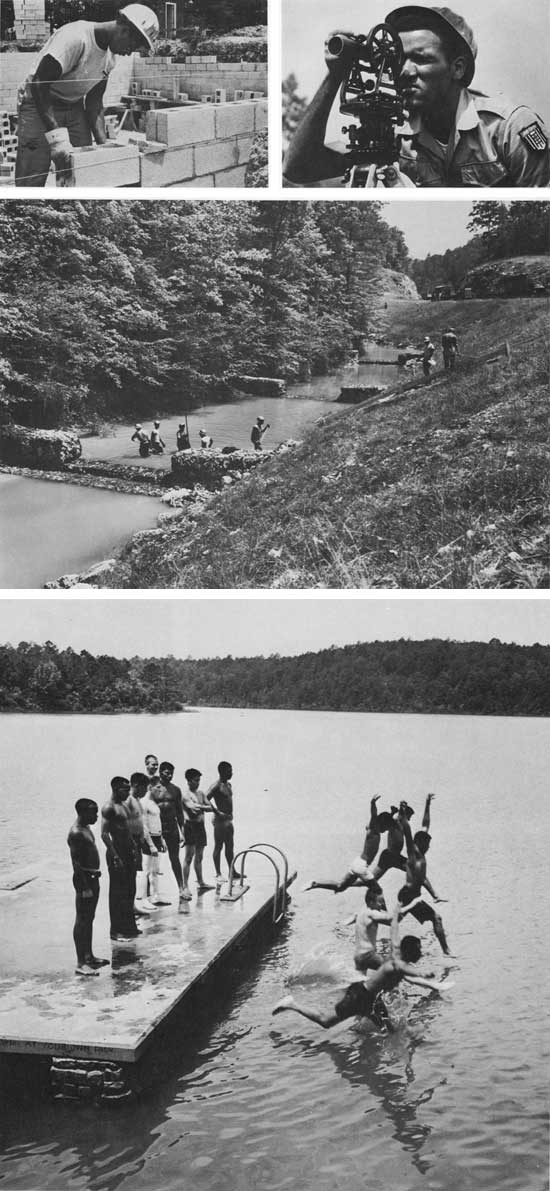
|
|
Jobs Corps . . . 1 (top left). In 1965, 8,000 disadvantaged 16-
to 21-year-old youths in the Job Corps were receiving basic education as well as
vocation-skills training in such fields as the construction of buildings . . . (F—519122)
2 (top right). Road surveys . . . (F—516177A) 3 (middle). Watershed protection and stream
improvement . . . (F—514892) 4 (bottom). Lifesaving and waterfront safety. (F—512536)
|
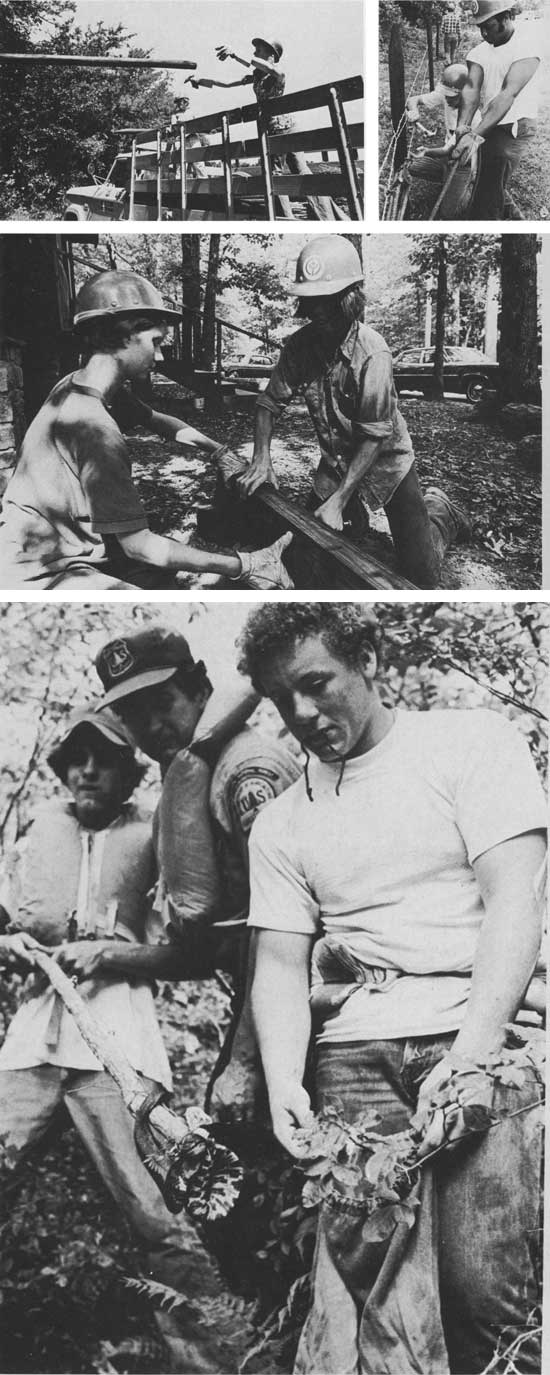
|
|
The Youth Conservation Corps is administered by the Forest
Service in cooperation with the Department of the Interior. The objectives:
to do needed conservation work on public lands; to provide gainful summer
employment for young men and women 15 to 18 years old; and to give these
young people the opportunity to gain an understanding and appreciation of
the Nation's environment and heritage. 1 (top left) & 2 (top right).
In 1975, the YCC had almost 13,000 participants in a variety of outdoor
activities, including the installation of fences . . . (Youth Conservation Corps,
0774 R 1138—7A; Youth Conservation Corps, 0774 R 1137—14A )
3 (middle). Construction of barriers to help control erosion and improve the
appearance of recreational areas . . . (Youth Conservation Corps, 0774 R 1134—25)
4 (bottom). Engaging in environmental awareness projects—such as
collecting snakes and other specimens to study for a better understanding of
the natural world. (Youth Conservation Corps, 0774 R 1135—34)
|
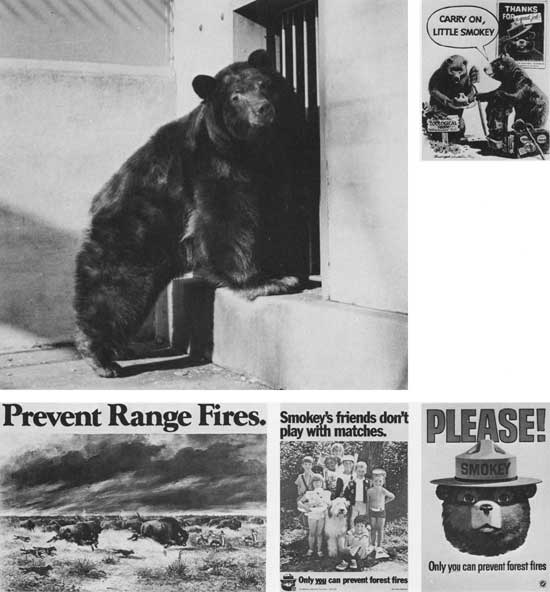
|
|
Long live Smokey Bear! 1 (top left) & 2 (top right). May 1975 saw the
original living symbol of forest fire prevention retiring after 25 years at the National
Zoo in Washington, D. C. On the same day, his successor was introduced to the public. (F—510947, Forest Service Cooperative Fire Protection)
3 (bottom left). The Ranger Poster for 1973. (Forest Service Cooperative Fire Protection, Rangeland Poster, 1937) 4 (center bottom) & 5 (bottom right).
Each year there is a poster which headlines the continuing program of the nationwide
forest fire prevention campaign, jointly conducted by the Forest Service and State
Forestry Departments with the cooperation of The Advertising Council, Inc. Many noted
artists and other professional people have supported the program in a practical way.
(Forest Service Cooperative Fire Protection, School Poster, 1968; Forest Service Cooperative Fire Protection, Basic Poster, 1965)
|
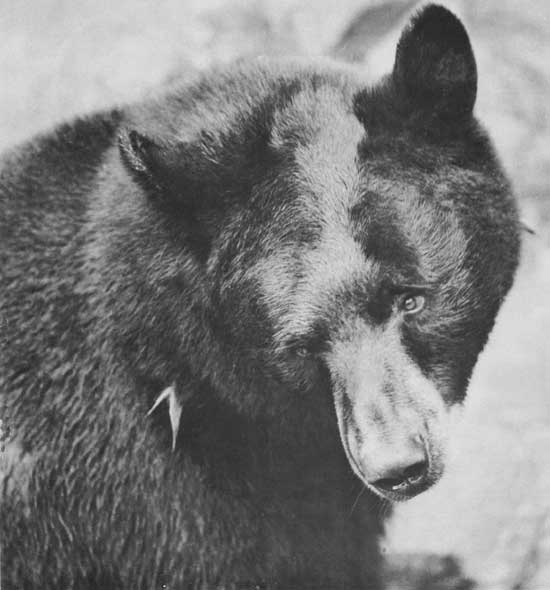
|
|
The new living symbol of Smokey Bear also came from New Mexico—the
original home of the first Smokey Bear. He had been abandoned and was searching for food
when he was rescued. After serving as an understudy for 4 years in the National Zoo,
he assumed his new role and greets the many children who come to see him. (Forest Service Cooperative Fire Protection)
|
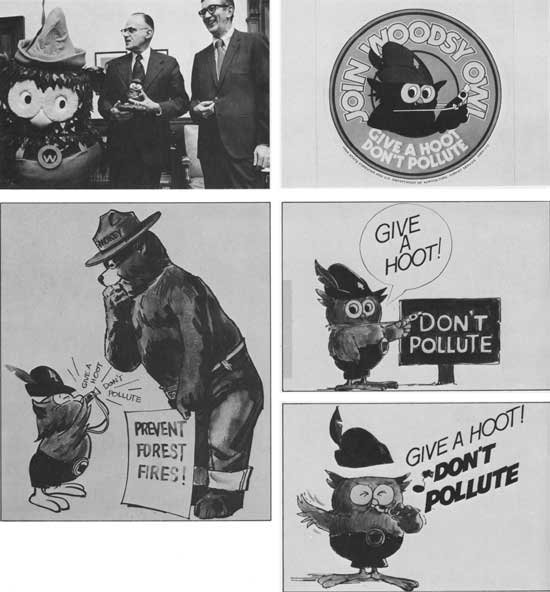
|
|
1 (top left). At a planning meeting in 1973, Agriculture Secretary
Earl Butz and Chief Forester John McGuire enjoy a laugh with Woodsy Owl, the Forest
Service's symbol of conventional awareness. (USDA 1272 A 1519—4 ) 2 (bottom left). "Give a hoot, don't
pollute" . . . This was the call heard throughout the land as the fire-preventing
Smokey Bear welcomed a new comrade, the pollution-preventing Woodsy Owl. (F—523664) 3 (top
right). The Woodsy Owl Program is conducted by the Forest Service with the
cooperation of the State Foresters and the Public Service Council. (F—623663) 4 (middle right).
Woodsy Owl made his public debut nationally in September 1971, was legalized as a
member of the U.S. Department of Agriculture conservation team by Act of Congress
in 1974, and set out to capture the imagination and cooperation of young and old
alike. (DN—3301) 5 (bottom right). Children made the decision as to how Woodsy Owl should
look. The environmental symbol represents their views, based on research interviews,
rather than those of adults. (DN—3301)
|
"Wilderness as a form of land-use is, of
course, premised on a qualitative conception of progress. It is premised on
the assumption that enlarging the range of individual experience is as
important as enlarging the number of individuals; that the expansion of
commerce is a means, not an end; that the environment of the American
pioneers had values of its own, and was not merely a punishment which they
endured in order that we might ride in motors. It is premised on the
assumption that the rocks and rills and templed hills of this America
are something more than economic materials, and should not be dedicated
exclusively to economic use . . ."
Aldo Leopold,
Forester and Wilderness Crusader
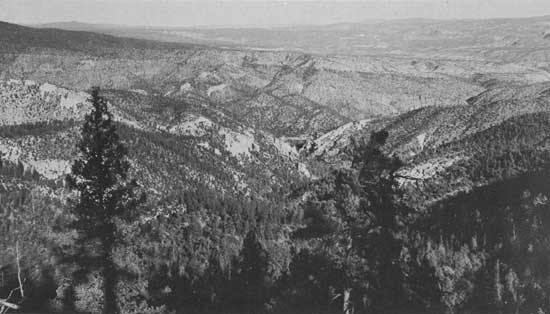
|
|
The Golden Anniversary of the First Wilderness . . . "June 3,
1924. On this date, the Forest Service of the U.S. Department of Agriculture
set aside the Nation's first tract of virtually untouched National Forest (the
Gila) and identified this naturalness as a resource as much so as timber, water,
forage, and wildlife—and called it Wilderness . . ." from the June 1974
"Forest Service News," Southwestern Region, Albuquerque, New Mexico. 1. The
first Wilderness set aside in the United States was the Gila Wilderness in the
Gila National Forest, New Mexico. Today the Gila Wilderness embraces 433,690
acres of wild, unspoiled land. Part of the Mogollon Plateau lies here, and
the area has steep, rugged canyons with many streams and rivers flowing through.
The Gila Wilderness has been extremely popular for its unique historic features,
outstanding scenery, fishing, hunting, and its solitude. (F—495787)
|
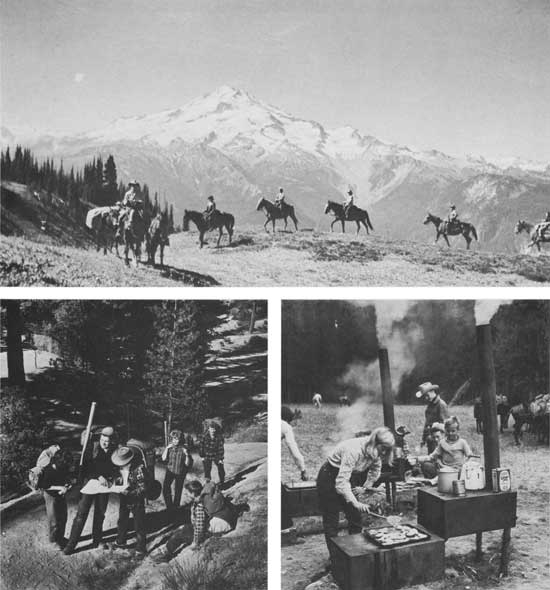
|
|
1 (top). Glacier Peak Wilderness Area, Mt. Baker National
Forest, Washington. (F—470126) 2 (bottom left). This family carefully planned their
trip as a picnic ground before heading into the San Gabriel Wilderness
Area, Angeles National Forest, California. (F—503164) 3 (bottom right). Trail riders
camp, Bob Marshall Wilderness Area, Flathead National Forest, Montana.
(F—520822)
|
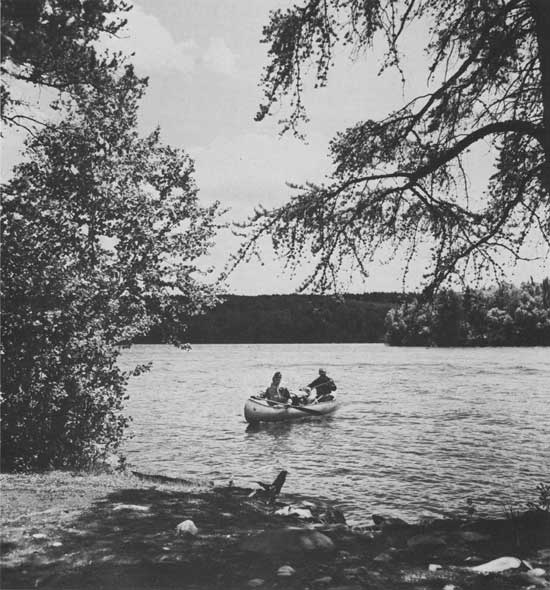
|
|
1. Heading for Moose Lake portage, Boundary Waters Canoe
Area (formerly Superior Wilderness), Superior National Forest, Minnesota.
(F—512328)
|
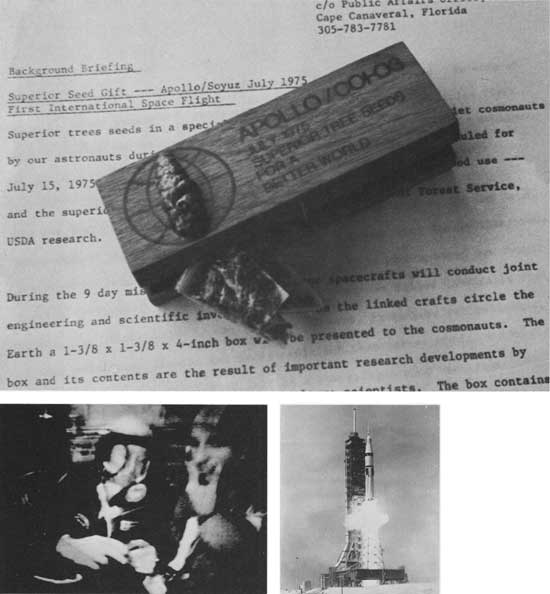
|
|
Little seeds to promote international goodwill . . . In an
historic mission in July 1975, during which American and Soviet space vehicles
meet in space for joint engineering and scientific investigations, a small box
of genetically superior white spruce seeds changed hands. The seeds were
developed by Forest Service scientists at the Institute of Forest Genetics
in Rhinelander, Wisconsin, and are expected to produce fast-growing trees of
exceptional height and shape. Enough seeds were given to the Soviet Cosmonauts
to grow an acre in the Moscow area, where the climate is similar to that of
Rhinelander. 1 (top). Small box, large implications. (Apollo-Soyuz Test Project) 2 (bottom left). The giving
of the gift of seeds took place on July 18, after the two craft had docked in
space. Apollo Commander Tom Stafford made the presentation to Soyuz Commander
Aleksey Leonov. (Apollo-Soyuz Test Project) 3 (bottom right). Apollo (a Saturn 1B launch vehicle) took off
for its space adventure with the Soyuz spacecraft in the afternoon of July 15.
The Soviet launch was in the morning of the same day. (National Aeronautics and Space Administration,
75—H—768 108—KSC—75P—392)
|
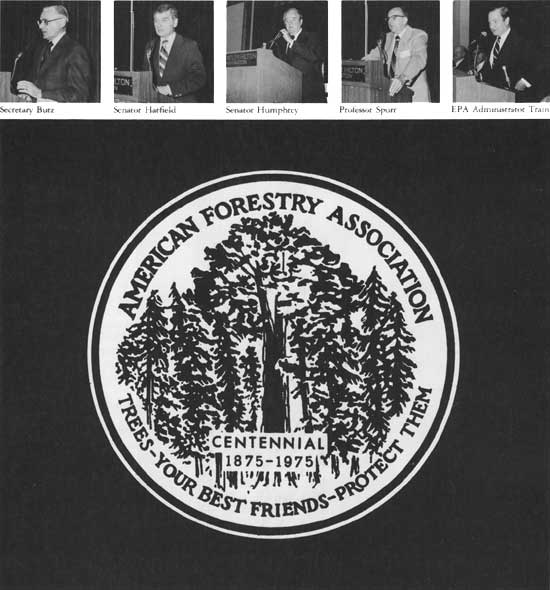
|
|
The American Forestry Association's Centennial feature—the
Sixth American Forest Congress . . . ". . . in line with present AFA policy now
in effect, the association's Directors zeroed in on the pressing need for an American
Forest Policy if the nation is to avoid a future forestry crunch not unlike today's
energy crunch. Forest policy, the Board said, is becoming a major national issue
and guidelines set down by Congress are urgently needed to avert or solve future
actions that could hamstring flexible resource management on the land . . ."
"American Forests" December 1975 Participants in AFA's Sixth American Forest Congress
included Secretary of Agriculture Earl Butz; Senator Mark Hatfield (Oregon); Senator
Hubert Humphrey (Minnesota), who, with Congressman John Rarick, cosponsored the Forest
and Rangeland Renewable Resources Planning Act of 1974; Administrator of the Environmental
Protection Agency Russell Train; and Dr. Stephen Spurr, University of Texas. These
speakers and others helped launch a national debate on "The Need for an American
Forest Policy." 1 (bottom). American Forestry Association Centennial Emblem. (American Forestry Association photographs)
|
aib-402/sec5.htm
Last Updated: 12-May-2008
|































